Hyundai Kona EV 2019 Owner's Manual
Manufacturer: HYUNDAI, Model Year: 2019, Model line: Kona EV, Model: Hyundai Kona EV 2019Pages: 540, PDF Size: 21.84 MB
Page 491 of 540
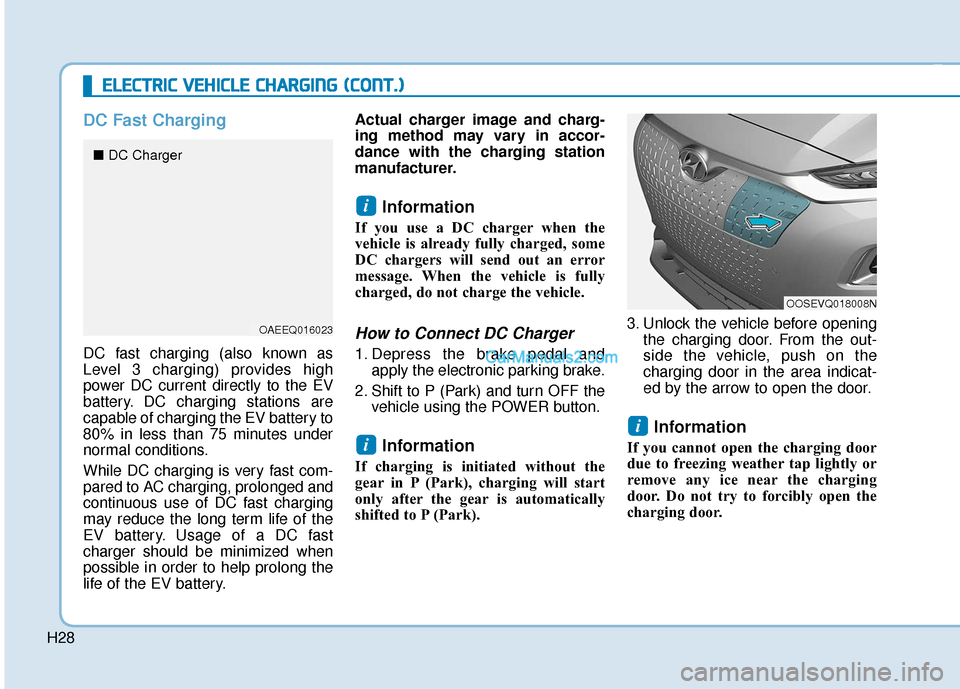
H28
DC Fast Charging
DC fast charging (also known as
Level 3 charging) provides high
power DC current directly to the EV
battery. DC charging stations are
capable of charging the EV battery to
80% in less than 75 minutes under
normal conditions.
While DC charging is very fast com-
pared to AC charging, prolonged and
continuous use of DC fast charging
may reduce the long term life of the
EV battery. Usage of a DC fast
charger should be minimized when
possible in order to help prolong the
life of the EV battery.Actual charger image and charg-
ing method may vary in accor-
dance with the charging station
manufacturer.
Information
If you use a DC charger when the
vehicle is already fully charged, some
DC chargers will send out an error
message. When the vehicle is fully
charged, do not charge the vehicle.
How to Connect DC Charger
1. Depress the brake pedal and
apply the electronic parking brake.
2. Shift to P (Park) and turn OFF the vehicle using the POWER button.
Information
If charging is initiated without the
gear in P (Park), charging will start
only after the gear is automatically
shifted to P (Park). 3. Unlock the vehicle before opening
the charging door. From the out-
side the vehicle, push on the
charging door in the area indicat-
ed by the arrow to open the door.
Information
If you cannot open the charging door
due to freezing weather tap lightly or
remove any ice near the charging
door. Do not try to forcibly open the
charging door.
i
i
i
E EL
LE
E C
CT
T R
R I
IC
C
V
V E
EH
H I
IC
C L
LE
E
C
C H
H A
AR
RG
G I
IN
N G
G
(
( C
C O
O N
NT
T.
.)
)
OOSEVQ018008N
OAEEQ016023
■ DC Charger
Page 492 of 540
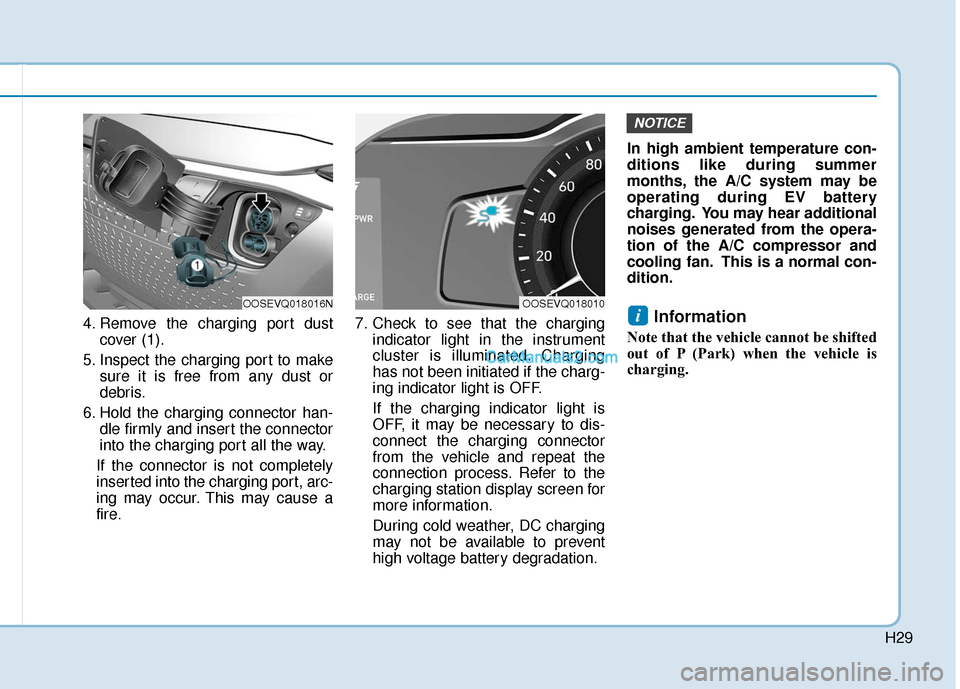
H29
4. Remove the charging port dustcover (1).
5. Inspect the charging port to make sure it is free from any dust or
debris.
6. Hold the charging connector han- dle firmly and insert the connector
into the charging port all the way.
If the connector is not completely
inserted into the charging port, arc-
ing may occur. This may cause a
fire. 7. Check to see that the charging
indicator light in the instrument
cluster is illuminated. Charging
has not been initiated if the charg-
ing indicator light is OFF.
If the charging indicator light is
OFF, it may be necessary to dis-
connect the charging connector
from the vehicle and repeat the
connection process. Refer to the
charging station display screen for
more information.
During cold weather, DC charging
may not be available to prevent
high voltage battery degradation. In high ambient temperature con-
ditions like during summer
months, the A/C system may be
operating during EV battery
charging. You may hear additional
noises generated from the opera-
tion of the A/C compressor and
cooling fan. This is a normal con-
dition.Information
Note that the vehicle cannot be shifted
out of P (Park) when the vehicle is
charging.
i
NOTICE
OOSEVQ018016NOOSEVQ018010
Page 493 of 540
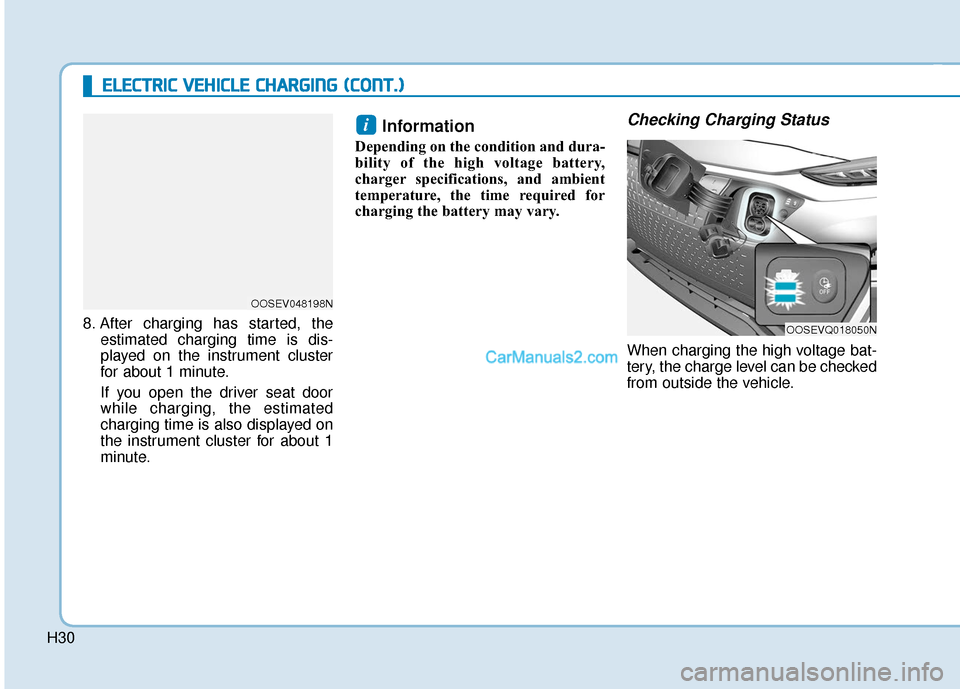
H30
E
EL
LE
E C
CT
T R
R I
IC
C
V
V E
EH
H I
IC
C L
LE
E
C
C H
H A
AR
RG
G I
IN
N G
G
(
( C
C O
O N
NT
T.
.)
)
8. After charging has started, the
estimated charging time is dis-
played on the instrument cluster
for about 1 minute.
If you open the driver seat door while charging, the estimated
charging time is also displayed on
the instrument cluster for about 1
minute.
Information
Depending on the condition and dura-
bility of the high voltage battery,
charger specifications, and ambient
temperature, the time required for
charging the battery may vary.
Checking Charging Status
When charging the high voltage bat-
tery, the charge level can be checked
from outside the vehicle.
i
OOSEVQ018050N
OOSEV048198N
Page 494 of 540
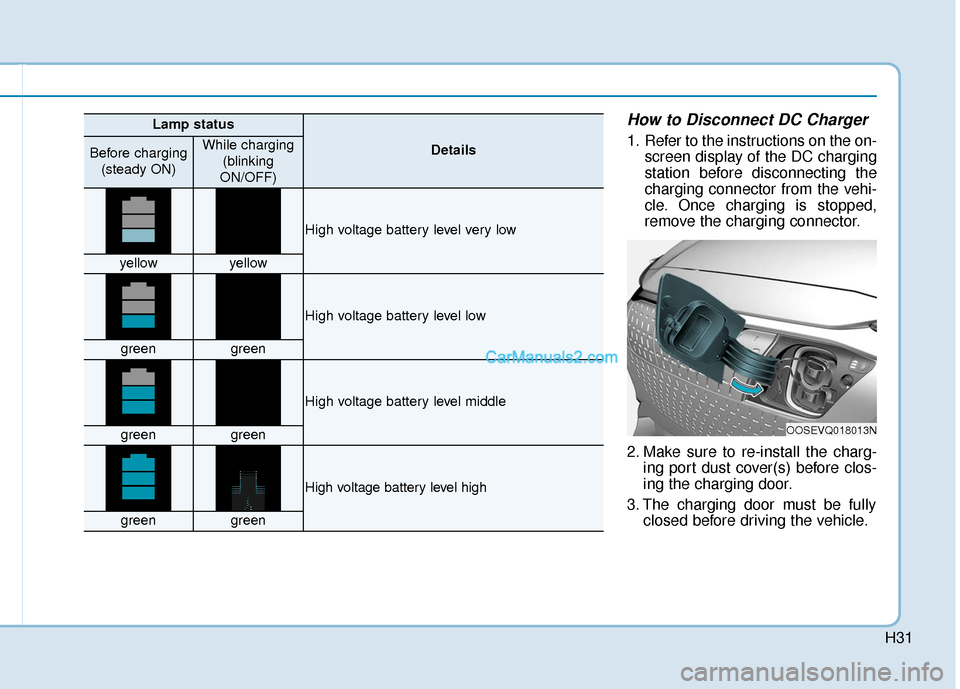
H31
How to Disconnect DC Charger
1. Refer to the instructions on the on-screen display of the DC charging
station before disconnecting the
charging connector from the vehi-
cle. Once charging is stopped,
remove the charging connector.
2. Make sure to re-install the charg- ing port dust cover(s) before clos-
ing the charging door.
3. The charging door must be fully closed before driving the vehicle.
OOSEVQ018013N
Lamp status
DetailsBefore charging
(steady ON)While charging (blinking
ON/OFF)
High voltage battery level very low
yellowyellow
High voltage battery level low
greengreen
High voltage battery level middle
greengreen
High voltage battery level high
greengreen
Page 495 of 540
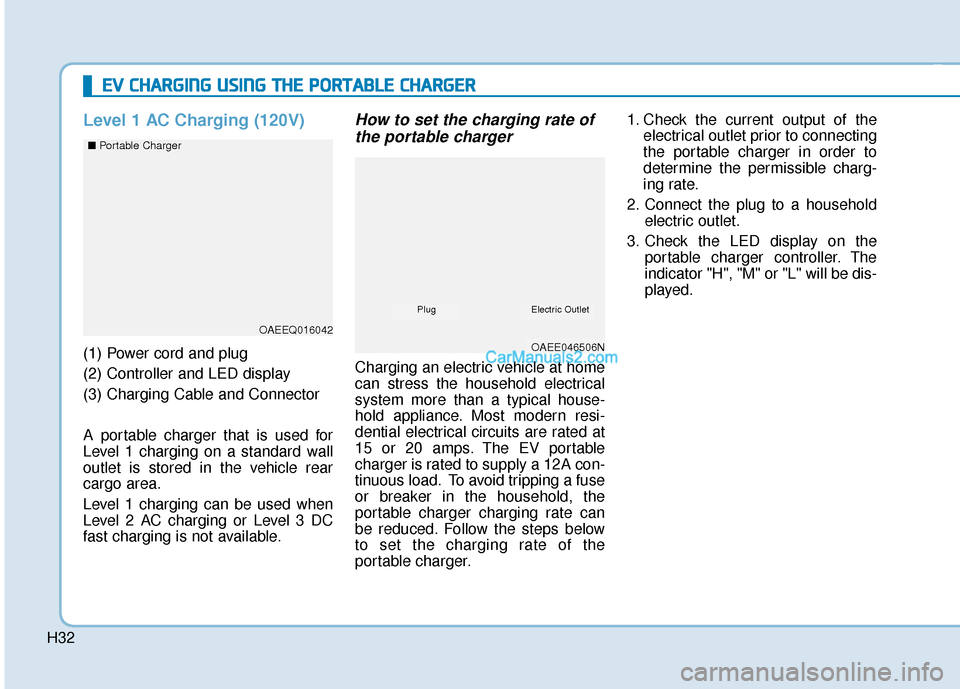
H32
Level 1 AC Charging (120V)
(1) Power cord and plug
(2) Controller and LED display
(3) Charging Cable and Connector
A portable charger that is used for
Level 1 charging on a standard wall
outlet is stored in the vehicle rear
cargo area.
Level 1 charging can be used when
Level 2 AC charging or Level 3 DC
fast charging is not available.
How to set the charging rate ofthe portable charger
Charging an electric vehicle at home
can stress the household electrical
system more than a typical house-
hold appliance. Most modern resi-
dential electrical circuits are rated at
15 or 20 amps. The EV portable
charger is rated to supply a 12A con-
tinuous load. To avoid tripping a fuse
or breaker in the household, the
portable charger charging rate can
be reduced. Follow the steps below
to set the charging rate of the
portable charger. 1. Check the current output of the
electrical outlet prior to connecting
the portable charger in order to
determine the permissible charg-
ing rate.
2. Connect the plug to a household electric outlet.
3. Check the LED display on the portable charger controller. The
indicator "H", "M" or "L" will be dis-
played.
E EV
V
C
C H
H A
AR
RG
G I
IN
N G
G
U
U S
SI
IN
N G
G
T
T H
H E
E
P
P O
O R
RT
TA
A B
BL
LE
E
C
C H
H A
AR
RG
G E
ER
R
OAEEQ016042
OAEE046506N
■
Portable Charger
Electric OutletPlug
Page 496 of 540
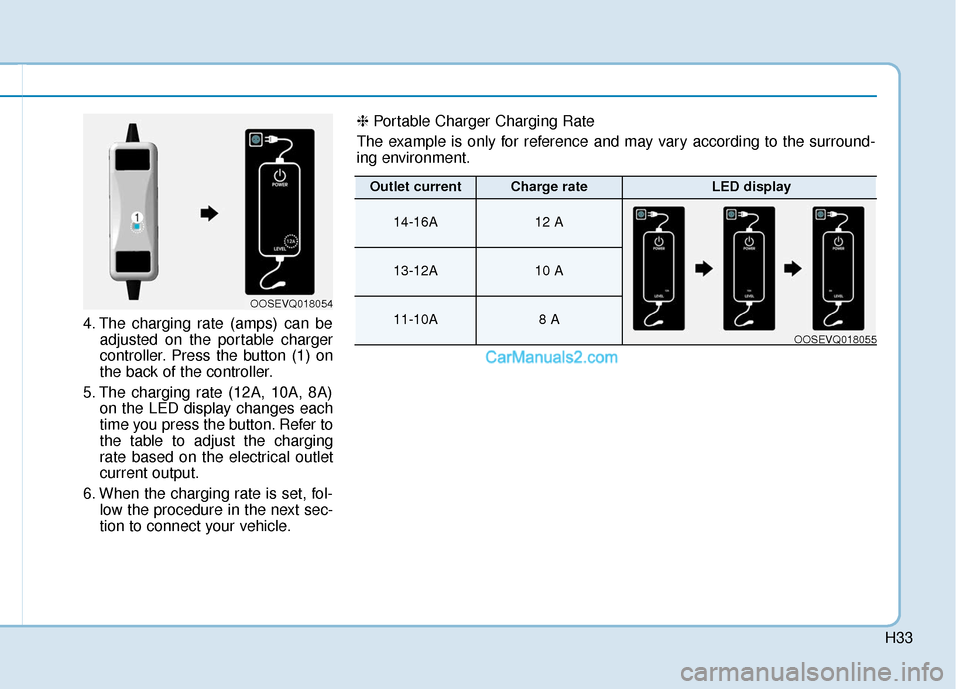
H33
4. The charging rate (amps) can beadjusted on the portable charger
controller. Press the button (1) on
the back of the controller.
5. The charging rate (12A, 10A, 8A) on the LED display changes each
time you press the button. Refer to
the table to adjust the charging
rate based on the electrical outlet
current output.
6. When the charging rate is set, fol- low the procedure in the next sec-
tion to connect your vehicle.
OOSEVQ018054
❈ Portable Charger Charging Rate
The example is only for reference and may vary according to the surround-
ing environment.
Outlet currentCharge rateLED display
14-16A12 A
13-12A10 A
11-10A8 A
OOSEVQ018055
Page 497 of 540
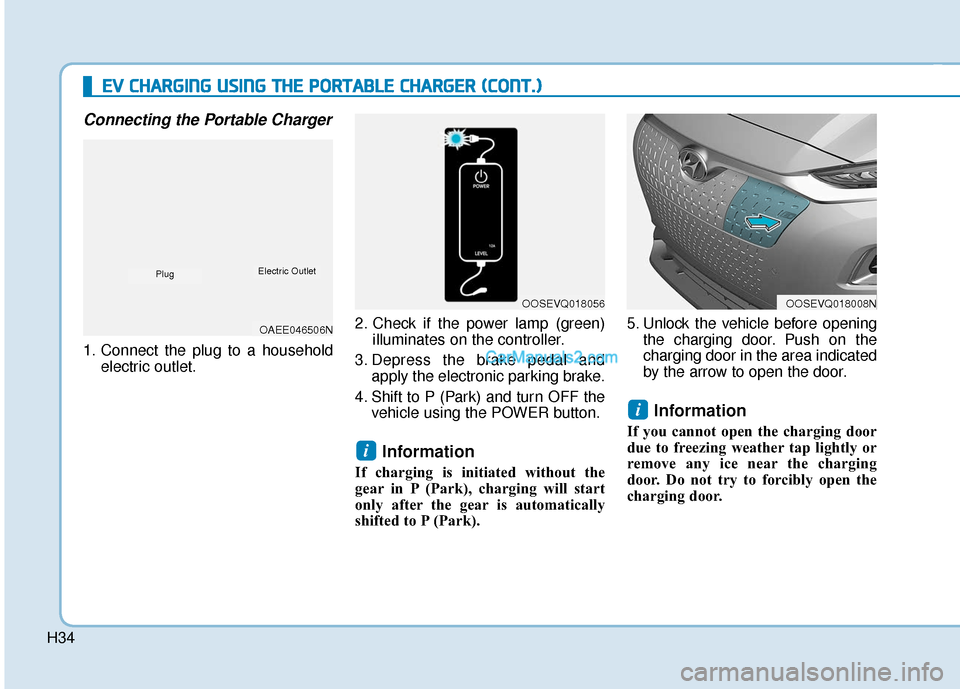
H34
Connecting the Portable Charger
1. Connect the plug to a householdelectric outlet. 2. Check if the power lamp (green)
illuminates on the controller.
3. Depress the brake pedal and apply the electronic parking brake.
4. Shift to P (Park) and turn OFF the vehicle using the POWER button.
Information
If charging is initiated without the
gear in P (Park), charging will start
only after the gear is automatically
shifted to P (Park). 5. Unlock the vehicle before opening
the charging door. Push on the
charging door in the area indicated
by the arrow to open the door.
Information
If you cannot open the charging door
due to freezing weather tap lightly or
remove any ice near the charging
door. Do not try to forcibly open the
charging door.
i
i
E
EV
V
C
C H
H A
AR
RG
G I
IN
N G
G
U
U S
SI
IN
N G
G
T
T H
H E
E
P
P O
O R
RT
TA
A B
BL
LE
E
C
C H
H A
AR
RG
G E
ER
R
(
( C
C O
O N
NT
T.
.)
)
OOSEVQ018056OOSEVQ018008N
OAEE046506N
PlugElectric Outlet
Page 498 of 540
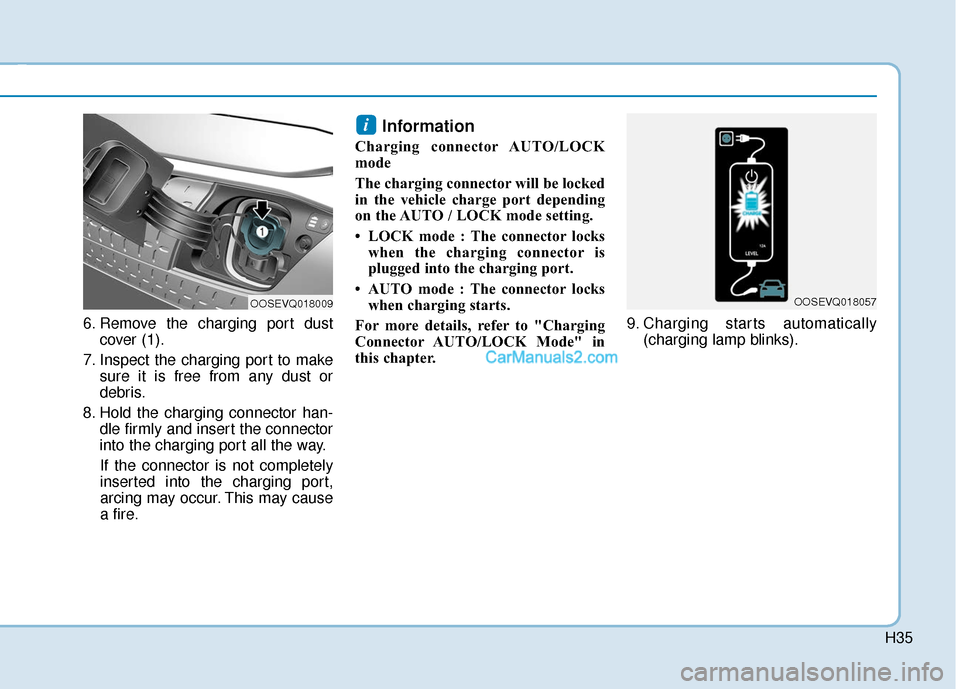
H35
6. Remove the charging port dustcover (1).
7. Inspect the charging port to make sure it is free from any dust or
debris.
8. Hold the charging connector han- dle firmly and insert the connector
into the charging port all the way.
If the connector is not completely
inserted into the charging port,
arcing may occur. This may cause
a fire.
Information
Charging connector AUTO/LOCK
mode
The charging connector will be locked
in the vehicle charge port depending
on the AUTO / LOCK mode setting.
• LOCK mode : The connector locks when the charging connector is
plugged into the charging port.
• AUTO mode : The connector locks when charging starts.
For more details, refer to "Charging
Connector AUTO/LOCK Mode" in
this chapter. 9. Charging starts automatically
(charging lamp blinks).
i
OOSEVQ018009OOSEVQ018057
Page 499 of 540
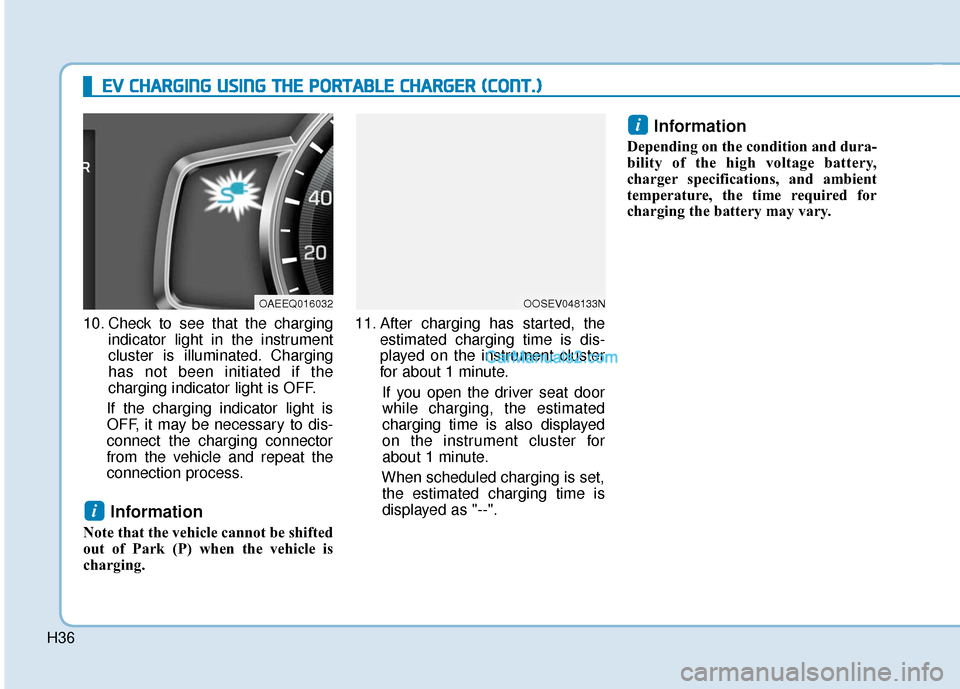
H36
E
EV
V
C
C H
H A
AR
RG
G I
IN
N G
G
U
U S
SI
IN
N G
G
T
T H
H E
E
P
P O
O R
RT
TA
A B
BL
LE
E
C
C H
H A
AR
RG
G E
ER
R
(
( C
C O
O N
NT
T.
.)
)
10. Check to see that the charging
indicator light in the instrument
cluster is illuminated. Charging
has not been initiated if the
charging indicator light is OFF.
If the charging indicator light is
OFF, it may be necessary to dis-
connect the charging connector
from the vehicle and repeat the
connection process.
Information
Note that the vehicle cannot be shifted
out of Park (P) when the vehicle is
charging. 11. After charging has started, the
estimated charging time is dis-
played on the instrument cluster
for about 1 minute.
If you open the driver seat door
while charging, the estimated
charging time is also displayed
on the instrument cluster for
about 1 minute.
When scheduled charging is set, the estimated charging time is
displayed as "--".
Information
Depending on the condition and dura-
bility of the high voltage battery,
charger specifications, and ambient
temperature, the time required for
charging the battery may vary.
i
i
OOSEV048133NOAEEQ016032
Page 500 of 540

H37
Checking Charging Status
When charging the high voltage bat-
tery, the charge level can be checked
from outside the vehicle.
OOSEVQ018050N
Lamp status
DetailsBefore charging(steady ON)While charging (blinking
ON/OFF)
High voltage battery level very low
yellowyellow
High voltage battery level low
greengreen
High voltage battery level middle
greengreen
High voltage battery level high
greengreen